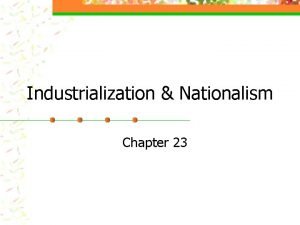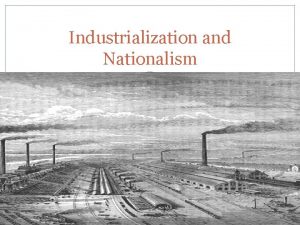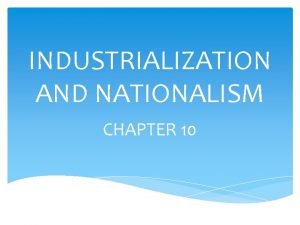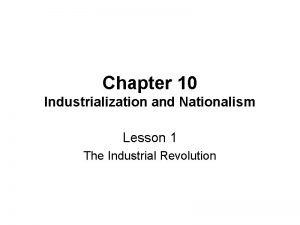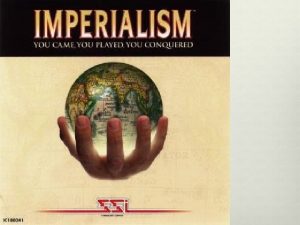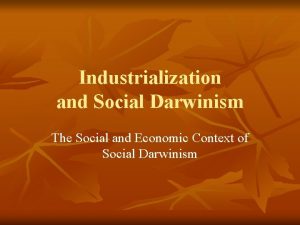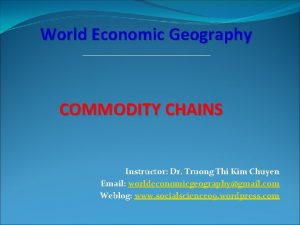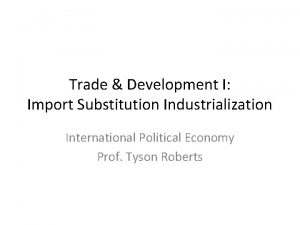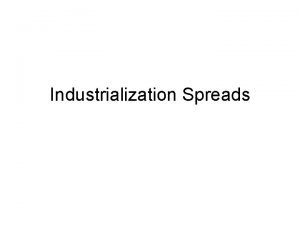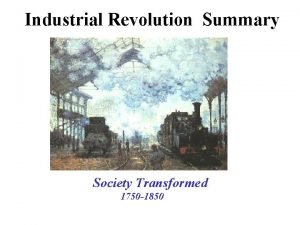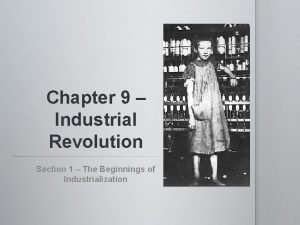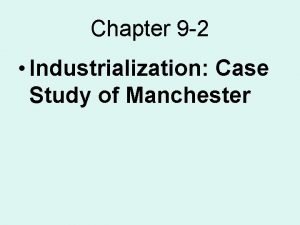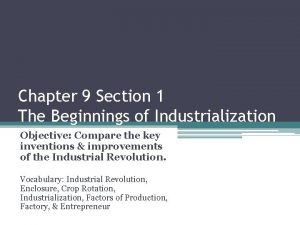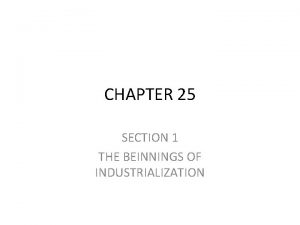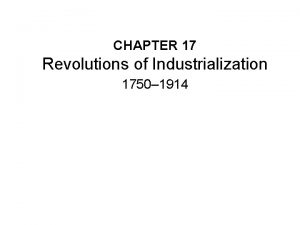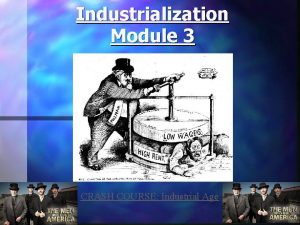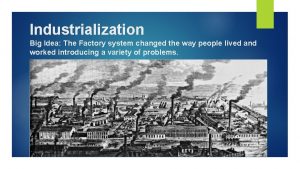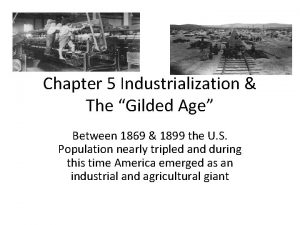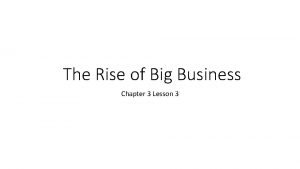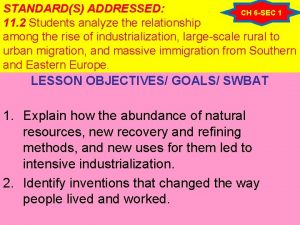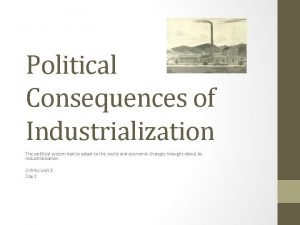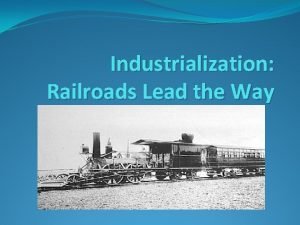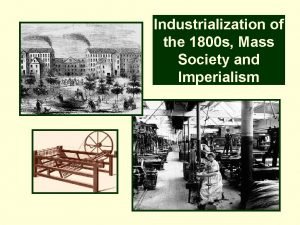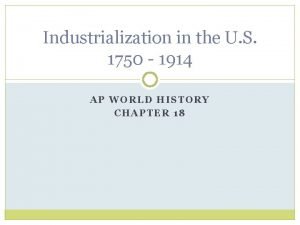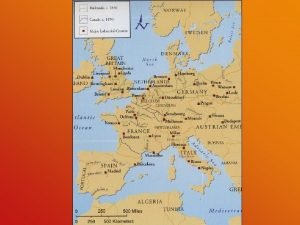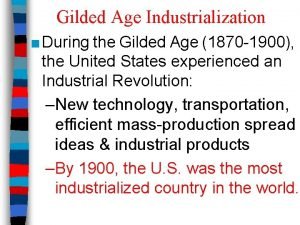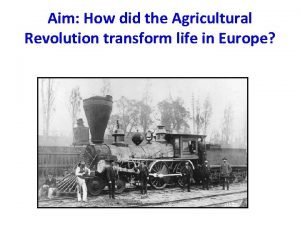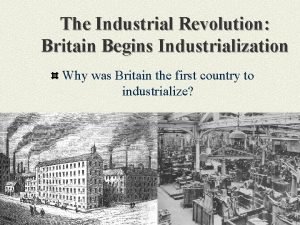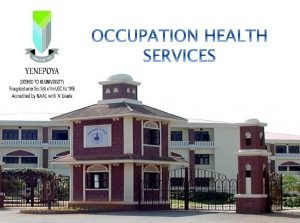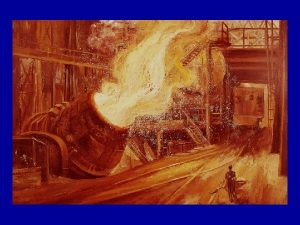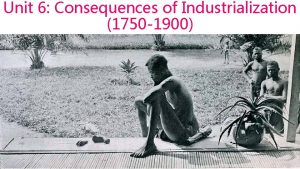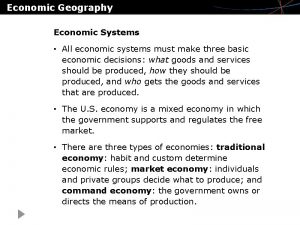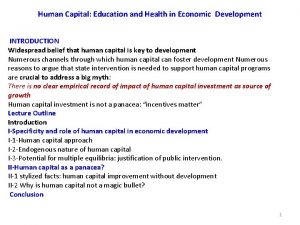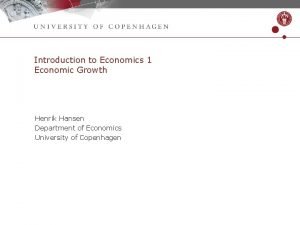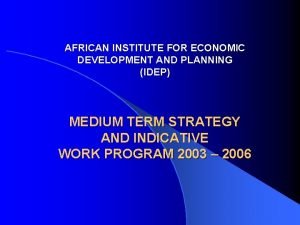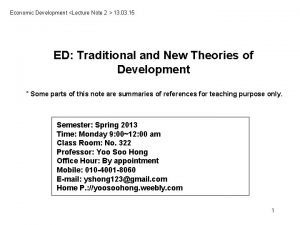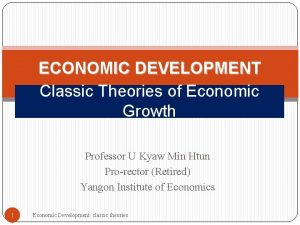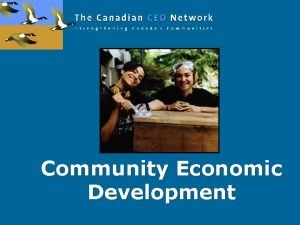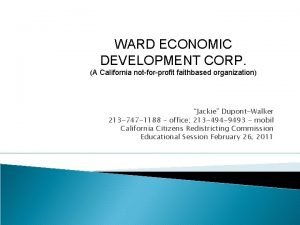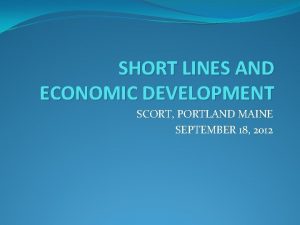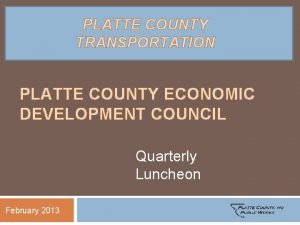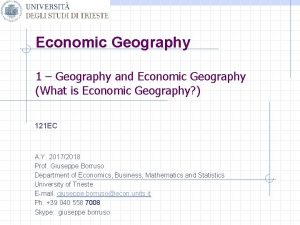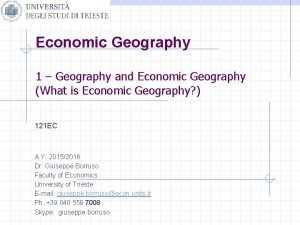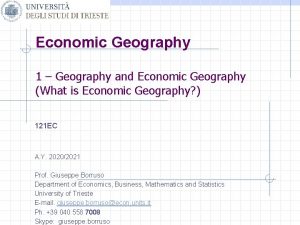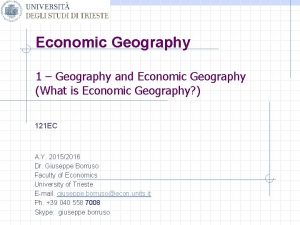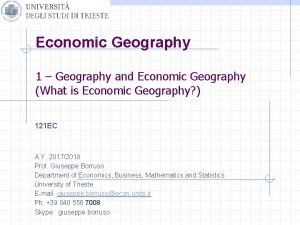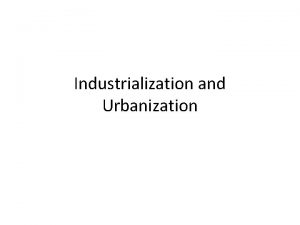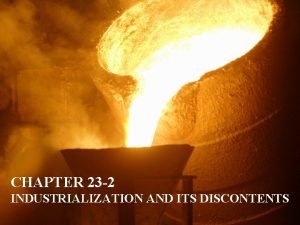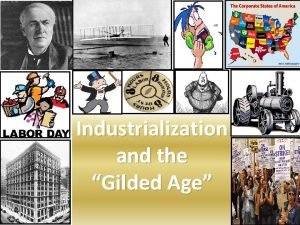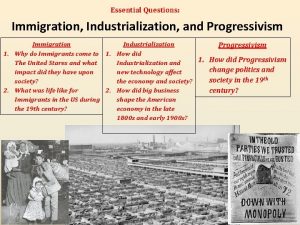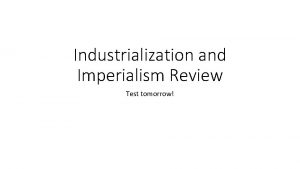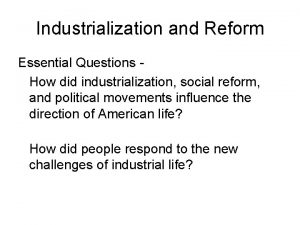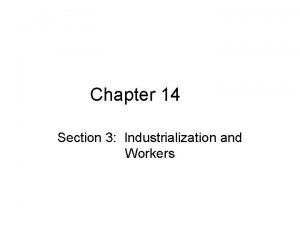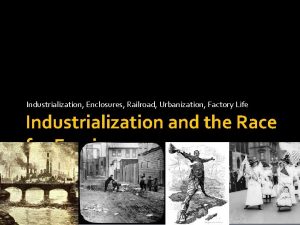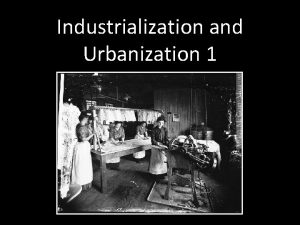INDUSTRIALIZATION AND ECONOMIC DEVELOPMENT ECONOMIC DEVELOPMENT Economic Geography












































































- Slides: 76

INDUSTRIALIZATION AND ECONOMIC DEVELOPMENT

ECONOMIC DEVELOPMENT � Economic Geography: study of flow of goods and services across space � Look at ways in which people provide for themselves across the globe � Geographic patterns of inequality at different scales � Globalization: is a MAJOR thread throughout economic geography…. free trade, international economic alliances, etc.

INDUSTRIAL REVOLUTION Industry: manufacturing goods in a factory � Industrial Revolution: � � Great Britain – late 1700 s – diffused to W. Europe and U. S. � Technology and mechanization led to unprecedented increase in production � Iron and textiles = 1 st to industrialize

Innovations in Machinery and transportation…. . railroads, steam engines, cotton gin, Bessemer converter, spinning jenny etc. INDUSTRIAL REVOLUTION

WHERE IS INDUSTRY DISTRIBUTED? � For 200 yrs industry was limited to � N. Europe – Great Britain, France, Russia, Germany � E. Asia – Japan � N. America – U. S. � These countries dominated industrial production/innovation until mid 20 th Century

WHERE IS INDUSTRY DISTRIBUTED � In recent yrs – shift in geography of industrialization � Major corporations have moved factories to LDCs (cheap labor) � Older industrial countries have shifted to service based economies – research and development, marketing, tourism, sales, telecommunications, etc. ) � Service jobs are safer, more pay, less pollution, and overall higher satisfaction

WHERE IS INDUSTRY DISTRIBUTED? � BUT service jobs require more education/training than factory work � i. e. difficult transition – factory lose jobs as factories outsource, must go back to school or switch careers in mid life � Mill towns/factory towns – ghost towns or reinvent themselves with new economic niche

WHERE IS INDUSTRY DISTRIBUTED? � Deindustrialization: when industrial factories leave an area and take that region’s economic base with them � Ex: Rust Belt: Great Lakes region was home to all auto manufacturing but GM and other companies have relocated – debilitating for the economy of the region and the workers there � Backwash Effect: when one region’s economic gain is another’s loss

THE RUST BELT

RUST BELT IMAGES

WHERE ARE INDUSTRIES DISTRIBUTED AND WHY THERE? � All industries seek to maximize profits by minimizing production costs � Critical question: Where is the most profitable place to locate a factory? ? � Alfred Weber: Least Cost Theory: firms look at the following to decide where to locate……. .

LEAST COST THEORY � 1. ) Transportation Costs: must move raw materials (inputs) to plant and finished product to market � Market Orientation Firms: if finished product weighs more or is perishable, then locate the plant closer to the market than the raw materials…. 4 types of market orientation:

LEAST COST THEORY – MARKET ORIENTED FIRMS A. ) Bulk Gaining Industry: product gains volume or weight during production (TV, refrigerator, soft drinks) � B. ) Single Market Manufacturer: product sold mainly in one location � C. Perishability: fresh fruits, milk, bread, newspaper – must be near market � D. Ubiquitious Industry: industry distribution is in direct proportion to the distribution of the population (i. e. near large metro areas with people = labor and market) i. e. hospitals, big business �

LEAST COST THEORY – MATERIAL/RESOURCE ORIENTATION � Material/Resource Orientation: raw materials (inputs) weigh more (or are perishable) than the finished product so locate plant closer to raw materials than to market. These are called Bulk Reducing Industries: final product weighs less than the inputs (i. e. paper mills, steel, copper – most mining, tomato cannery, etc. )

LEAST COST THEORY – OTHER TRANSPORTATION VARIABLES Footloose firms: industries w/ products that are lightweight and valuable and can locate anywhere (i. e. diamond of computer chips) � Spatially fixed cost: cost of product does not change no matter where factory is located � Spatially Variable cost: price of product varies depending on where factory is located and where product is produced �

LEAST COST THEORY – OTHER TRANSPORTATION VARIABLES � Transportation – ship, rail, truck, or air?

LEAST COST THEORY - TRANSPORTATION � Longer distance is cheaper mile � Ships best for longest distances � Air – most expensive but fastest � Break of Bulk Points: cost of transport for some inputs is cheaper than another type of transport – so you use multiple methods of transport. BBP = transfer point (usually a seaport or airport)

LEAST COST THEORY - AGGLOMERATION � Agglomeration: when many companies of the same industry cluster together in a small area to draw from the same set of collective resources (i. e. computer companies in Silicon Valley, motion picture industry in LA, fashion in Paris)

WITH A PARTNER: � What are some other examples of agglomeration that you can think of?

LEAST COST THEORY - AGGLOMERATION � Multiplier Effect: as more firms from same industry locate in an area, more resources become available and cements that region’s specialty even more (ex: CA became known for high tech firms, it attracted more computer experts, which attracted more high tech firms, etc. )

LEAST COST THEORY - AGGLOMERATION � Ancillary Activities: agglomeration results in ancillary activities – i. e. the supporting cast. Economic activities that surround/support the primary industry of the region. These can include a range of activities – shipping, food services, etc.

LEAST COST THEORY - AGGLOMERATION � Agglomeration leads to regionalization: unique specialization from region to region � Deglomeration: opposite of agglomeration – when a firm leaves an agglomerated region to start up in a new place

LEAST COST THEORY – AGGLOMERATION REGIONAL SPECIALIZATION – SILICON VALLEY

LEAST COST THEORY – LABOR Labor intensive industry = one where the cost of labor is a high percentage of production (ex: textiles) � Outsourcing: move production abroad for cheap labor. You’re willing to pay more for transportation b/c of cheap labor. Outsourcing usually goes to semi-periphery – cheap labor, decent infrastructure, no environmental regs �

LEAST COST THEORY – LABOR � Textiles has followed cheap labor – originally in NE because of cheap immigrant labor, late 1800 s/early 1900 s moved to SE to avoid unions, post WW II moved overseas to LDCs in Asia (50 s in Hong Kong and Japan, 70’s in China and Korea, today in Indonesia, Bangladesh

LEAST COST THEORY – OTHER THINGS A FIRM MAY CONSIDER…… � Land: Factories today usually rural or suburban � Need large tracts of land (1 story – more efficient) � Amenities – climate, cost of living, re opportunities (i. e. Sun Belt) � Communities engage in bidding wars – zoning, tax breaks, environmental conditions, etc. to offer most attractive package (i. e. Dell in NC) �

LEAST COST THEORY – OTHER THINGS A FIRM MAY CONSIDER…. � Capital � Money available to expand or open new factories � May go to area where banks are willing to make high risk loans (i. e. Silicon Valley)

FACTORY WORK � Fordism: mass production and assembly lines (each worker assigned one specific task to perform repeatedly). Started by Ford in early 20 th Century

FACTORY WORK � Post-Fordism: more flexible – work in teams and often master a wide array of tasks

WEBER’S FACTORS TO CONSIDER = SITE AND SITUATION FACTORS � Site Factors: land, labor, capital � Situation Factors: transportation costs – i. e. relative location to inputs/raw materials and to market

SUMMARY OF LOCATION PRINCIPLES � Access to materials for production � Adequate supply of cheap labor � Proximity to shipping and market � Decrease production costs (cheap land, cheap labor, and favorable government policies) � Natural factors, climate � Firm’s history and personal inclinations

INDUSTRIAL PROBLEMS � Over production – global capacity to produce manufactured goods has increased more rapidly than demand � Consumption � No leveled off since 1970 s because population increase � Wages have not risen as fast as prices � Market Saturation: everyone already has one (TV, cars, microwaves, etc. ) � Higher quality goods last longer

INDUSTRIAL PROBLEMS IN MDCS � Must protect markets from new competitors � Trading Blocs: industrial competition in MDCs is between blocs, not countries � NAFTA, EU, ASEAN � Cooperation within bloc, competition between � Seek complementary trade within bloc

INDUSTRIAL PROBLEMS IN MDCS � Transnational Corporations – locate aspects of production in various countries. i. e. take advantage or regional diff in wages, tax laws, labor laws, natural resources, etc. � Ex: Nike – HQ in Oregon, but factories span the globe

INDUSTRIAL PROBLEMS IN MDCS � Most transnational corporations are conglomerate corporations: firms that consist of many smaller firms that serve different functions (ex: GM – many smaller firms that operate all over the world, and produce a wide variety of goods and services

INDUSTRIAL PROBLEMS IN LDCS � Distance from markets – far from wealthy consumers in MDCs � Poor infrastructure (roads, technology, communication, etc. ) � Cheap labor = best drawing card for industry. International division of labor: low paid, low skilled work done in LDCs, high skilled work in MDCs

INDUSTRIAL PROBLEMS IN LDCS � Export Processing Zones: zones officially designated for manufacturing – have accessible facilities, lax environmental regulations, and tax exemptions, cheap labor. Ex: Maquiladoras along US/MX border. � Pros – jobs for MX, cheap labor for US. � Cons – often plagues with high crime, government corruption, pollution

INDUSTRY TODAY…. . � Outsourcing � Export processing zones - maquiladoras � Tourism � All of these exploit LDCs/periphery. Neocolonialism: economic and political controls are exercised by developed states over the economies and societies of independent countries in the developing world

DEVELOPMENT � Development: process of improving material conditions of people with diffusion of knowledge and technology – continuous process of trying to improve health, living conditions, and prosperity � Wallerstein’s World Systems Model � N/S Divide (see handout)

DEVELOPMENT VARIES ACROSS SPACE Development can be broken into economic, social, or demographic factors � Human Development Index (HDI): created by UN to look at all 3 � Life exp, education (literacy rate and amount of education), income (GDP) � Highest possible – 1. 0 (100%) � Norway – highest -. 944 � U. S. never first, but always high � Lowest - sub Sahara Africa (Sierra Leone. 275) �

ECONOMIC FACTORS OF DEVELOPMENT � GNP and GDP (omits investments abroad) � GNP (Gross National Product): the market value of all the products and services produced in one year by labor and property supplied by the residents of a country � GDP (Gross Domestic Product): the market value of all officially recognized final goods and services produced within a country in a given period of time � Per capita (divide by population) � Annual per capita GDP more than $20, 000 in MDCs and @ $1, 000 in LDCs – this gap is widening

ECONOMIC FACTORS OF DEVELOPMENT � Types of jobs…. � Primary activities: with land – fishing, farming � Secondary: manufacturing, industry � Tertiary: service � Quaternary: research and development – generating/exchanging knowledge (teaching, banking, law, accounting, etc. ) � Quinary: high tech scientific research

TYPES OF JOBS/ECON ACTIVITIES

ECONOMIC FACTORS OF DEVELOPMENT All countries have all types of economic activities. The higher up you go, the more education required and the better pay. MDC’s mostly in tertiary or higher. LDC’s mostly in primary. Semi-periphery mostly in secondary. � Human Resources and productivity increase in MDCs (workers produce more w/ less effort)…. higher education, skilled, machinery and technology �

ECONOMIC FACTORS OF DEVELOPMENT � Energy Consumption per capita – correlates with technology and development � MDCs =10 X more per capita than LDCs � MDCs consume more energy than they produce � MDCs use coal, natural gas, hydropower � LDCs use firewood, dung, peat, and domestic fuels to cook and keep warm � Wood – 60% of fuel use in LDCs and 90% in poorest countries

SOCIAL INDICATORS OF DEVELOPMENT � MDCs use money for schools, hospitals, that provide better education and healthier longer lives – this is cyclical because better educated and healthier population can be more productive and make more money

SOCIAL INDICATORS OF DEVELOPMENT � Education: MDC’s have greater quantity and quality of education � Student – teacher ratio (2 X as many students to 1 teacher in LDC) � Literacy Rate (over 95% in MDCs, less than 35% in LDCs) � Average student attends school 10 yrs in MDC and a few yrs in LDCs (varies)

SOCIAL INDICATORS OF DEVELOPMENT � Health � MDCs – better ratio of people to hospitals, doctors, and nurses � MDC consume greater calorie consumption. In LDCs many get less than daily recommended allowance � Different problems……MDCs – problems with obesity, elderly population, etc.

DEMOGRAPHIC INDICATORS OF DEVELOPMENT � Life Expectancy: average # of yrs a newborn can expect to live (early 40 s in LDCs, 70 s in MDCs) � Infant Mortality: die before 1 st b-day (less than 1% in MDCs, 10% in LDCs) � CBR – higher in LDCs but dropping � Maternal Mortality Rate –higher in LDCs

GENDER ISSUES IN DEVELOPMENT � Gender � Two inequality exists in every country composite measures to look at……

GDI GENDER RELATED DEVELOPMENT INDEX � GDI: looks at same measure as HDI but to highlight disparity between men and women � Complete equality is 1. 0 � Penalized for greater difference between men and women � Highest GDIs in Europe and N. America; lowest in Sub Sahara Africa � Even in MDCs women’s average income is less than men’s

GDI � In LDC’s women less likely to attend school and have lower literacy rates (99/100 women to men in MDC high school; 60/100 in LDC high schools) (remember this affect on population growth) � Globally women outlive men, but outlive men much longer in MDCs than in LDCs (mostly because of maternal mortality rate)

GENDER EMPOWERMENT MEASURE (GEM) � Measures economic and political power � 4 factors…. � Income � Professional jobs � Managerial jobs � Elected positions (no country has a national Congress w/ majority women…highest in Europe with @ 30%. . U. S. has @ 15%)

� Every nation has a higher GDI and lower GEM i. e. means women possess a greater share of a nation’s resources than power over allocation of those resources � Even in MDCs women’s average income is less than men’s…WHY?

LDCS OBSTACLES TO DEVELOPMENT While LDCs have improved, gap between MDC and LDC has increased. � WHY? Circular/cumulative causation: process where tendency for economic growth are selfreinforcing…. i. e. it takes money and development to foster money and development � Solution? LDCs must develop at a faster rate, but how? Two prominent options…. �

SELF SUFFICIENCY/BALANCED GROWTH APPROACH – CHINA AND INDIA � Country should invest = across all sectors of the economy and all regions � Limit imports (tariffs) � Internal businesses encouraged to produce for own people; not export

PROBLEMS WITH SELF-SUFFICIENCY MODEL � Protects inefficient businesses in own country (protect from international competition, but has little incentive to improve quality or lower price) � HUGE government bureaucracy to manage economy – leads to abuse and corruption – Government red tape

OPTION TWO – INTERNATIONAL TRADE MODEL � Develop through international trade (look outward). Look outward. Identify a unique economic asset and export globally. Use funds and profit to finance other development � Done in Arabian peninsula and E/SE Asia

W. W. ROSTOW – DEVELOPMENT MODEL � Rostow advocated international trade approach with a 5 step model towards development. He created the model in the 1950 s and based it on the pathway the U. S. and Europe followed: � Stage 1: Traditional Society: country dominated by primary economic activities – low production, low tech, low per capita income

ROSTOW – INTERNATIONAL TRADE Stage 2: Preconditions to Takeoff: preconditions to economic development are commercialization of AG and exploitation of raw materials � Stage 3: Takeoff: foreign investment jump starts econ. Rapid growth in a limited number of sectors; other sectors still dominated by traditional methods. Country uses profits to pour into infrastructure (roads, canals, etc. ) �

ROSTOW – INTERNATIONAL TRADE � Stage 4: Drive to Maturity: Development and modern technology diffuse to wider variety of the economy. Workers become more skilled and specialized � Stage 5: high levels of mass consumption and per capita income. Shift from heavy industry to services and producing consumer goods.


CRITICISMS OF ROSTOW Not all countries will pass through stages consecutively � Model doesn’t account for…. � Global politics � Colonialism � Physical geography � War � Culture � Ethnic conflict � All of these may affect progression and cause different pathway �

EXAMPLE OF INTNL TRADE MODEL � 4 Asian Tigers/Dragons: S. Korea, Singapore, Taiwan, Hong Kong all poor in natural resources � Promoted development by focusing on a handful of economic goods (especially clothing and electronics). i. e. find comparative advantage – produce item for which you have the greatest advantages in comparison to other countries � Low labor allowed them to sell products cheaply in MDCs �

MAP – ASIA � India – China – initially self/sufficiency and balanced growth model � 4 Asian Tigers – International Trade Model

4 ASIAN TIGERS � South Korea � Taiwan � Hong Kong � Singapore

PROBLEMS WITH INTERNATIONAL TRADE MODEL � May hinder other LDC’s from following this path…. � 1. ) Uneven resource distribution: many country's niche faced lower price on world market (ex: Zambia and copper – world prices for copper have been dropping) � 2. ) Market stagnation: market for consumer goods slowing down in general

PROBLEMS WITH INTERNATIONAL TRADE MODEL � 3. ) Increased dependence on MDCs: takeoff industries force LDCs to decrease production of food, clothing, or other necessities for own people � Conclusion…. international trade model is widely accepted alternative to self-sufficiency model

STATISTICS…… � World Bank – since 1990 per capita GDP has increased more than 4% annually in countries with international trade model and less than 1% in countries with self-sufficiency model

STATISTICS…. . � 1960 -1990…. . � India’s GDP increased by 4%/year on self sufficiency model � Thailand’s by 8%/year (international trade) � Taiwan’s by 8%/year (international trade) � S. Korea’s by 9% /year (international trade) � Since 1990 s India switched to international trade and GDP has increased by 6%/year

WTO – WORLD TRADE ORGANIZATION � Established in 1995 – promotes international trade model. Works to decrease barriers to international trade by…. � Eliminating restriction on trade (no tariffs, no quotas on imports, no subsidies on exports) � Enforcing trade agreements (rules on arguments and accusations)

WTO � Liberal critics – say WTO is anti-democratic and promotes interests of large, wealthy, transnational corporations � Conservative critics – says WTO compromises governments of countries because it can order changes in subsidies, taxes, etc. � ALWAYS protestors outside WTO meetings

WTO

$$$$$ FOR DEVELOPMENT? ? � 1. ) Loans – usually from World Bank or International Monetary Fund (both controlled by MDCs) � Together loan @ 50 billion/year � Idea – borrow $$ to improve infrastructure to attract businesses/investment � Many infrastructure projects fail – don’t work, don’t pay off, or businesses still do not come

$$$$ FOR DEVELOPMENT? � (Loans) � Debt is greater than annual income in 30 countries � Many LDCs cannot even pay interest on loans, much less the principal � Result…. many MDC’s becoming more hesitant to grant loans

$$$$ FOR DEVELOPMENT? ? � 2. ) Foreign Direct Investment – Transnational Corporations: flow of money and investment from one country to another through private corporations (increasing trend in late 20 th C) BUT only ¼ of foreign investment went from MDC to LDC (most goes from MDC to MDC) � Of all money from MDC to LDC, ½ of that goes to Brazil, China, MX �
 What is economic growth and development
What is economic growth and development Economic growth vs economic development
Economic growth vs economic development Revolution
Revolution Lesson quiz 10-1 industrialization and nationalism
Lesson quiz 10-1 industrialization and nationalism Chapter 10 industrialization and nationalism
Chapter 10 industrialization and nationalism Chapter 10 lesson 1 the industrial revolution
Chapter 10 lesson 1 the industrial revolution Under imperialism the stronger nation attempts to
Under imperialism the stronger nation attempts to Social darwinism definition industrial revolution
Social darwinism definition industrial revolution Commodity chain ap human geography definition
Commodity chain ap human geography definition Ap human geography frq format
Ap human geography frq format 5 themes of geography ap human geography
5 themes of geography ap human geography Ap human geography political geography test
Ap human geography political geography test Import substitution industrialization
Import substitution industrialization Industrialization causes
Industrialization causes Industrialization definition ap world history
Industrialization definition ap world history Ubiquitous ap human geography
Ubiquitous ap human geography Chapter 25 section 3 industrialization spreads
Chapter 25 section 3 industrialization spreads Industrialization spreads chapter 9 section 3
Industrialization spreads chapter 9 section 3 Chapter 9 section 3 industrialization spreads answer key
Chapter 9 section 3 industrialization spreads answer key Deglomeration definition
Deglomeration definition Chapter 3 industrialization (1865 to 1901 answers)
Chapter 3 industrialization (1865 to 1901 answers) Result of industrialization
Result of industrialization Industrialization causes
Industrialization causes The beginnings of industrialization chapter 9 section 1
The beginnings of industrialization chapter 9 section 1 Chapter 9 section 2 industrialization case study manchester
Chapter 9 section 2 industrialization case study manchester The beginnings of industrialization
The beginnings of industrialization Chapter 9 section 1 the beginnings of industrialization
Chapter 9 section 1 the beginnings of industrialization Spinning mule long term effects
Spinning mule long term effects Chapter 17 revolutions of industrialization
Chapter 17 revolutions of industrialization Industrialization crash course
Industrialization crash course William cooper industrial revolution
William cooper industrial revolution Lesson 5 - industrialization
Lesson 5 - industrialization Whats the definition of industrialization
Whats the definition of industrialization Industrialization
Industrialization Chapter 3 lesson 3 big business
Chapter 3 lesson 3 big business Which resources played crucial roles in industrialization
Which resources played crucial roles in industrialization Consequences of industrialization
Consequences of industrialization Pools industrialization definition
Pools industrialization definition Industrialization
Industrialization Industrialization
Industrialization Albanla
Albanla Industrialization
Industrialization Industrialization
Industrialization Industrialization definition
Industrialization definition What is industrialization
What is industrialization Pharmacy act 1948 slideshare
Pharmacy act 1948 slideshare What is industrialization
What is industrialization Industrialization (1865 to 1901 worksheet answers key)
Industrialization (1865 to 1901 worksheet answers key) Def of industrialization
Def of industrialization 8th grade history staar test review games
8th grade history staar test review games Industrialization of continental europe
Industrialization of continental europe Philosophers of industrialization
Philosophers of industrialization Nation state
Nation state Economic geography
Economic geography Economic geography
Economic geography Types of economic geography
Types of economic geography Economic systems lesson 2 our economic choices
Economic systems lesson 2 our economic choices Human capital education and health in economic development
Human capital education and health in economic development Economic growth and development
Economic growth and development Swodf
Swodf African institute for economic development and planning
African institute for economic development and planning Anocracy definition ap human geography
Anocracy definition ap human geography Infill development definition ap human geography
Infill development definition ap human geography Human development index definition ap human geography
Human development index definition ap human geography Environmental sustainability ap human geography
Environmental sustainability ap human geography Rostow's development model
Rostow's development model Wake county economic development
Wake county economic development Economic social development
Economic social development Northern waterfront economic development initiative
Northern waterfront economic development initiative Economic social development
Economic social development Classic theories of economic development: four approaches
Classic theories of economic development: four approaches 2 positive effects of primate cities
2 positive effects of primate cities Canadian community economic development network
Canadian community economic development network Ward economic development corporation
Ward economic development corporation Scort portland
Scort portland Platte county economic development
Platte county economic development Heather candler
Heather candler


